Charles E W Bean, Diaries, AWM38 3DRL 606/249/1 - 1917 - 1932 - Part 14
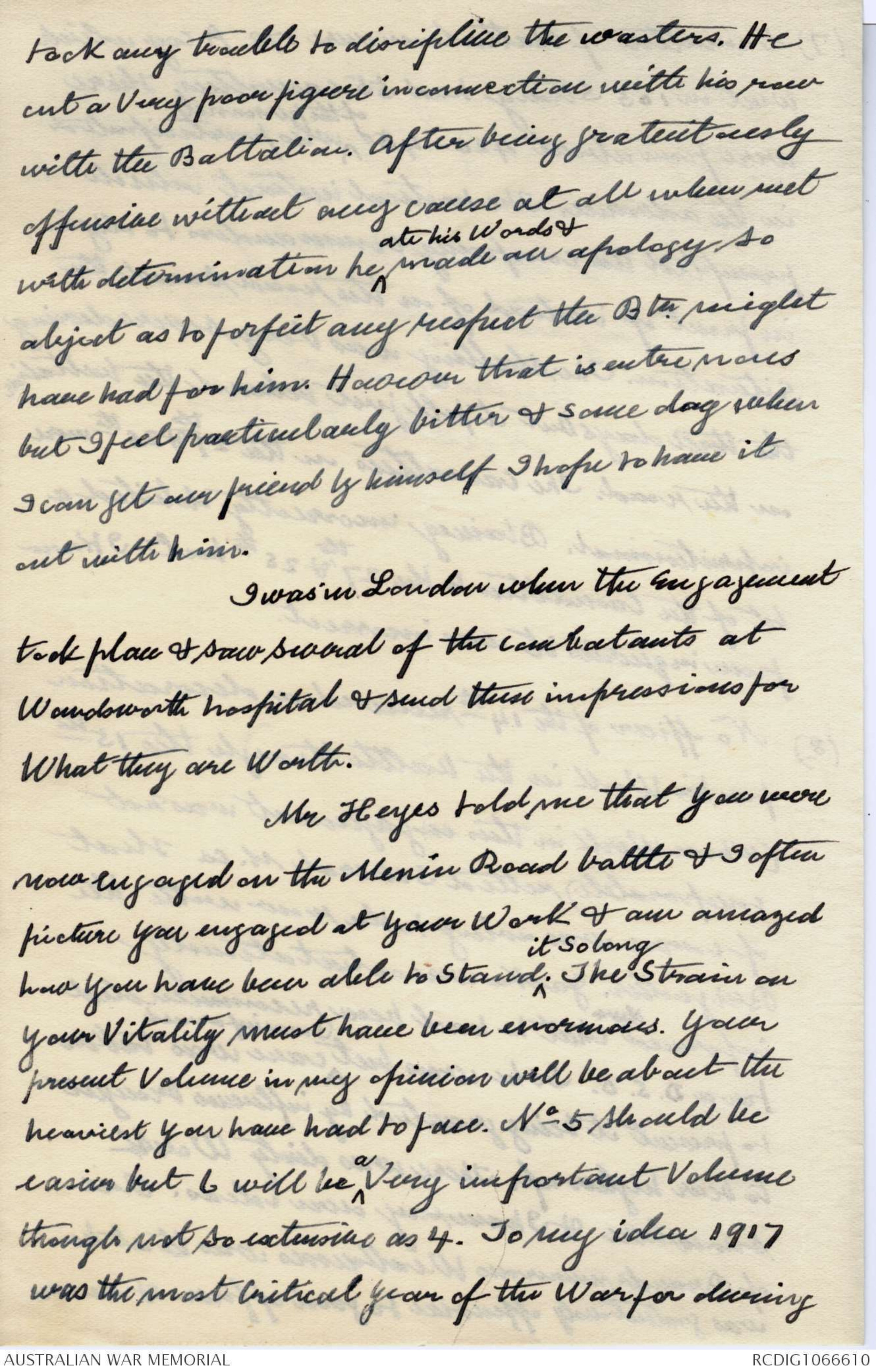
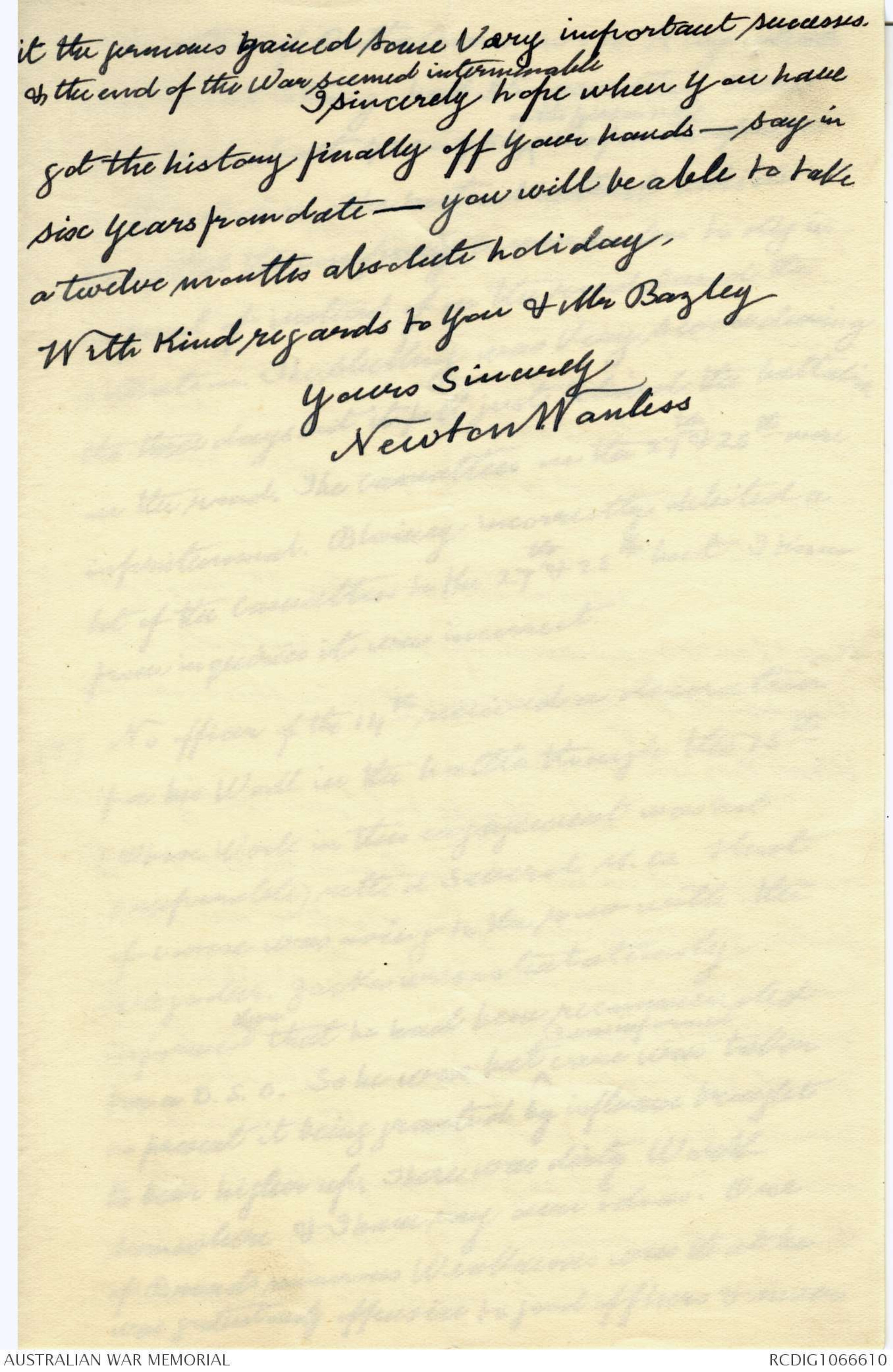
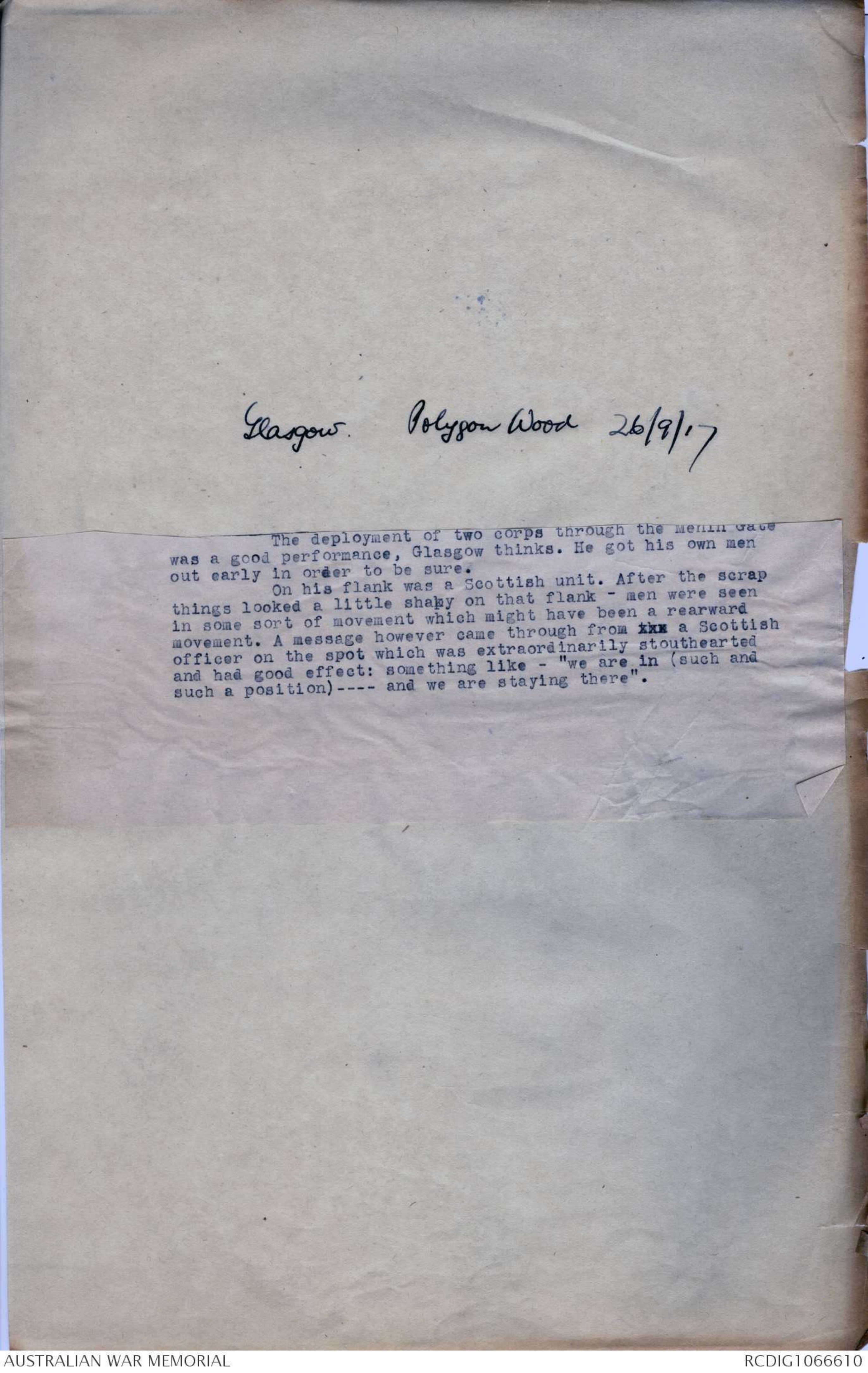
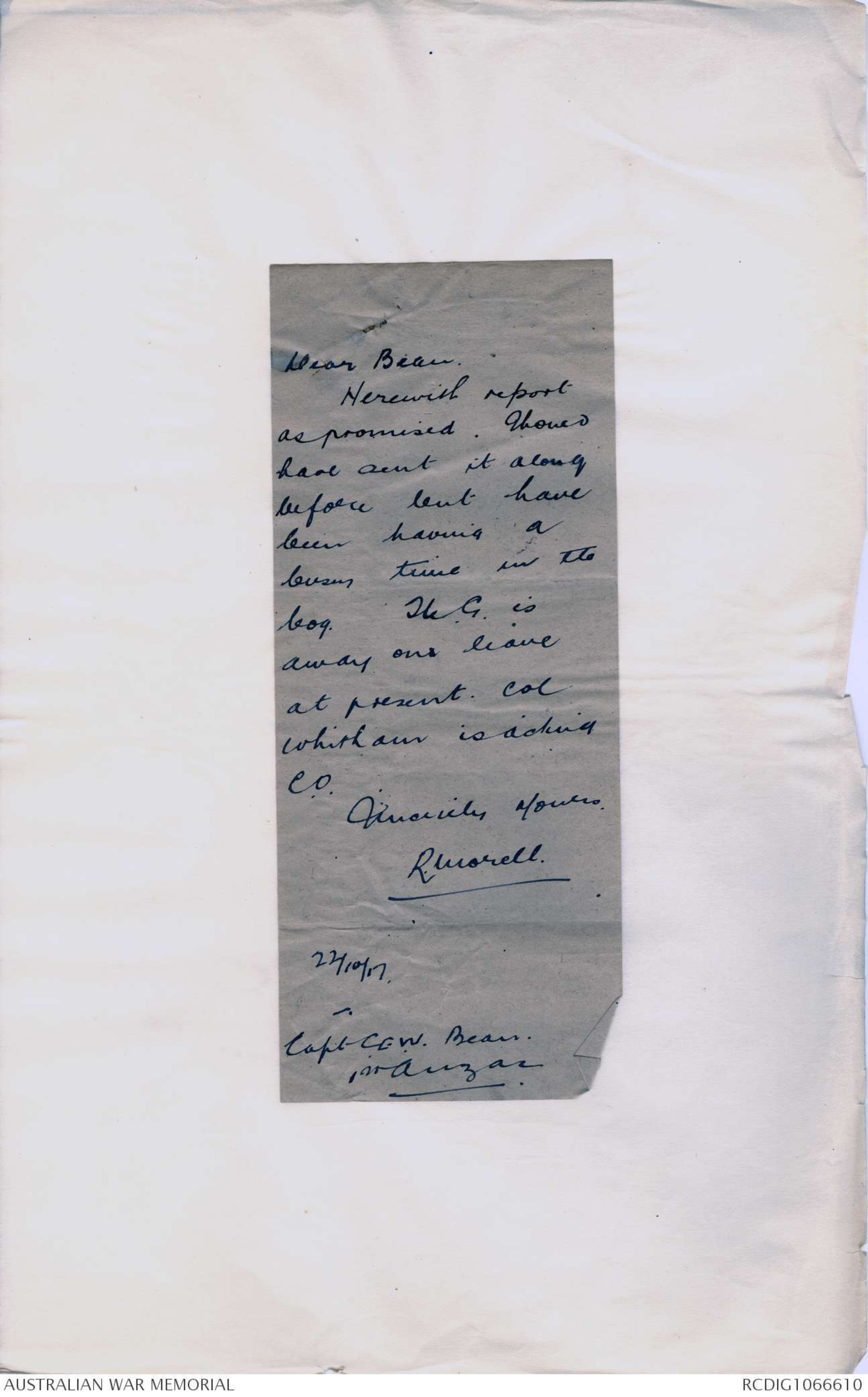
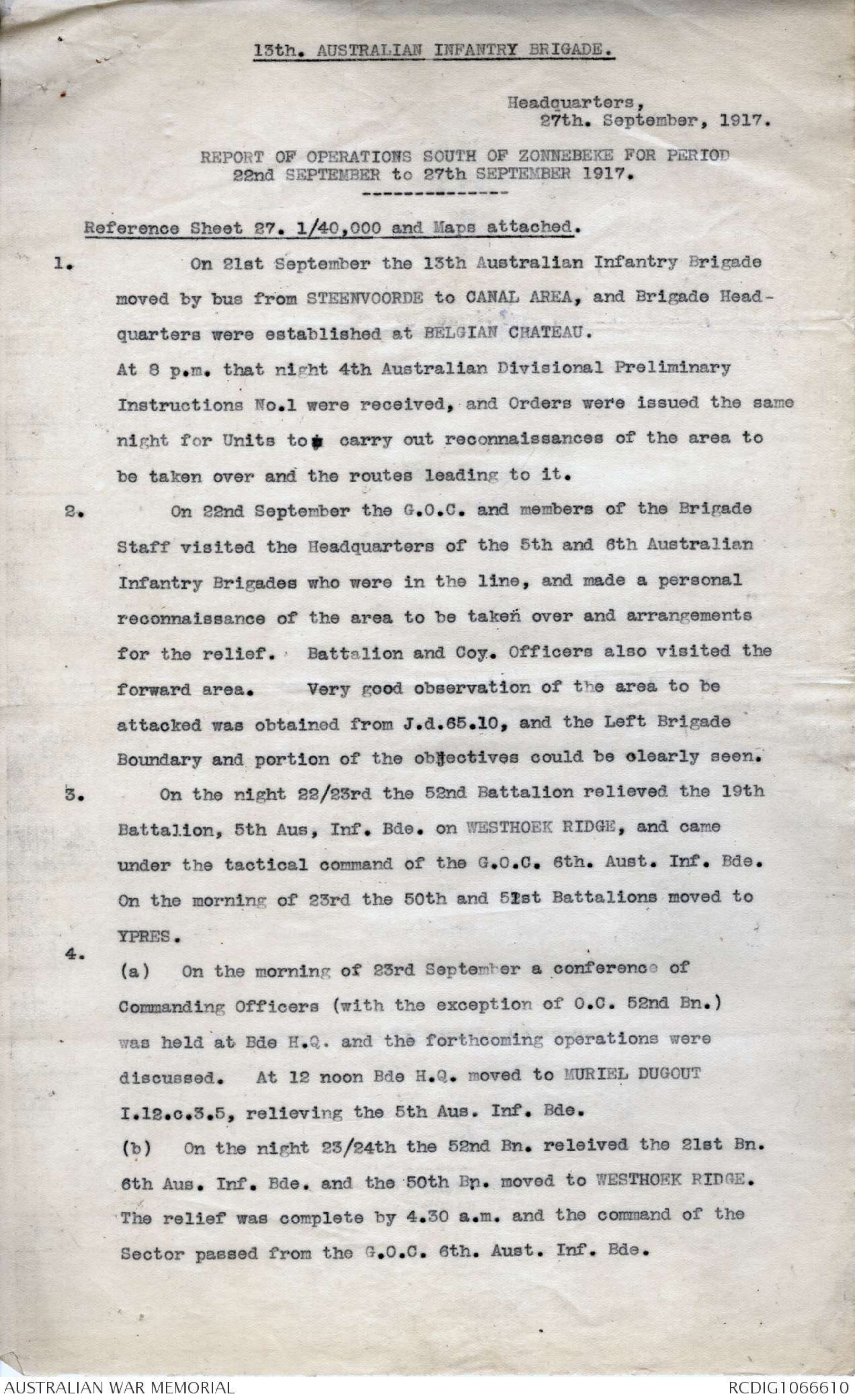
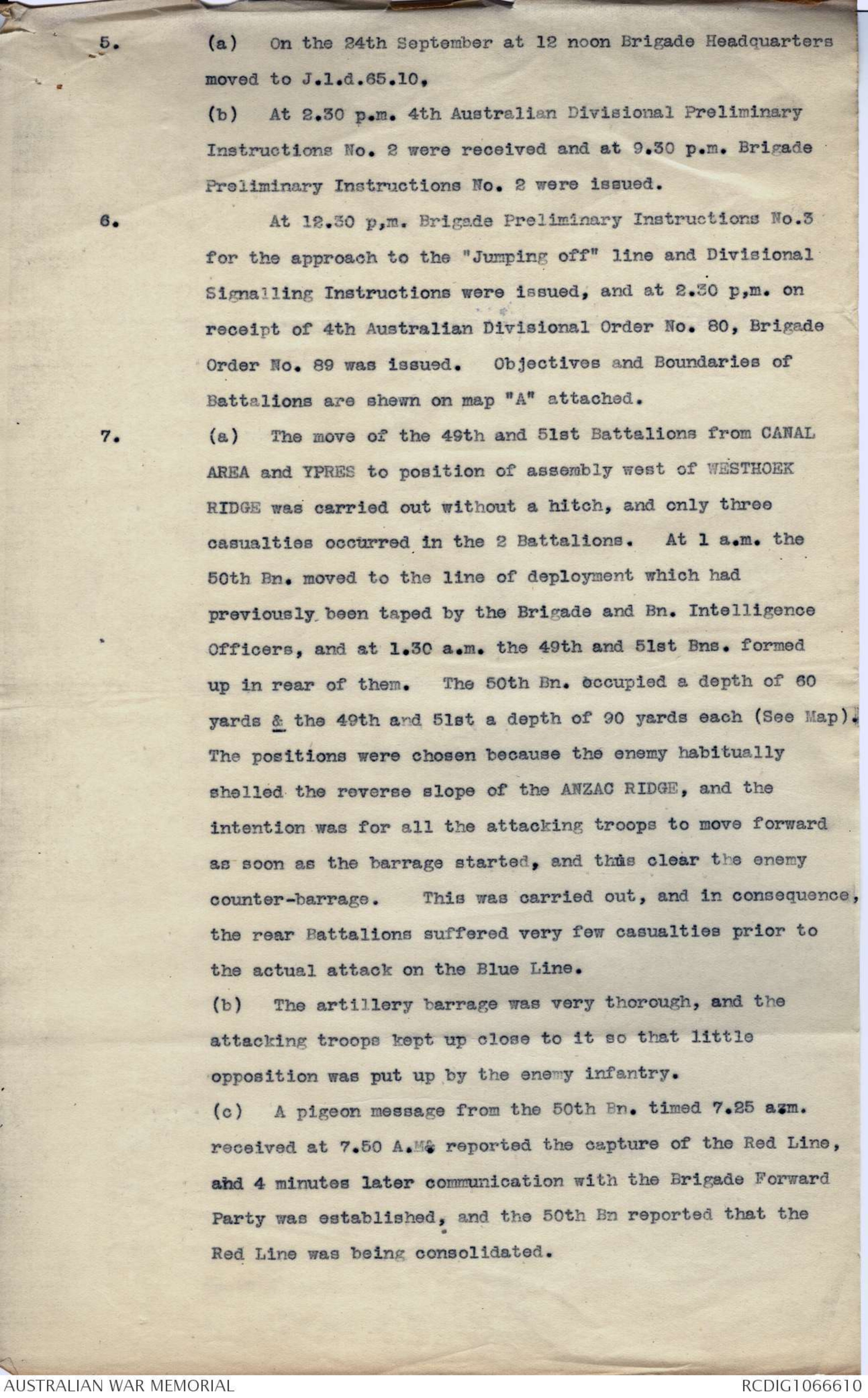
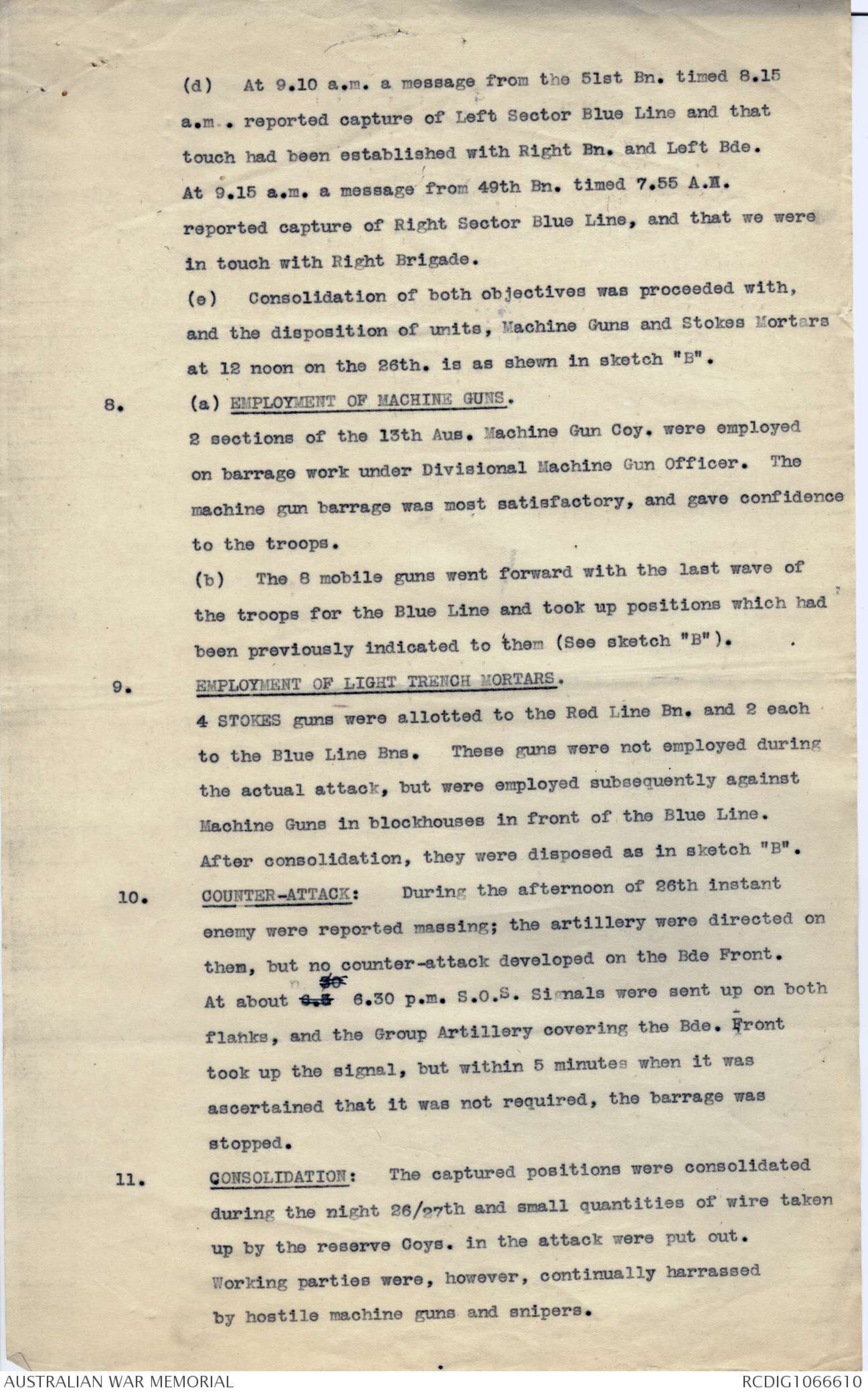
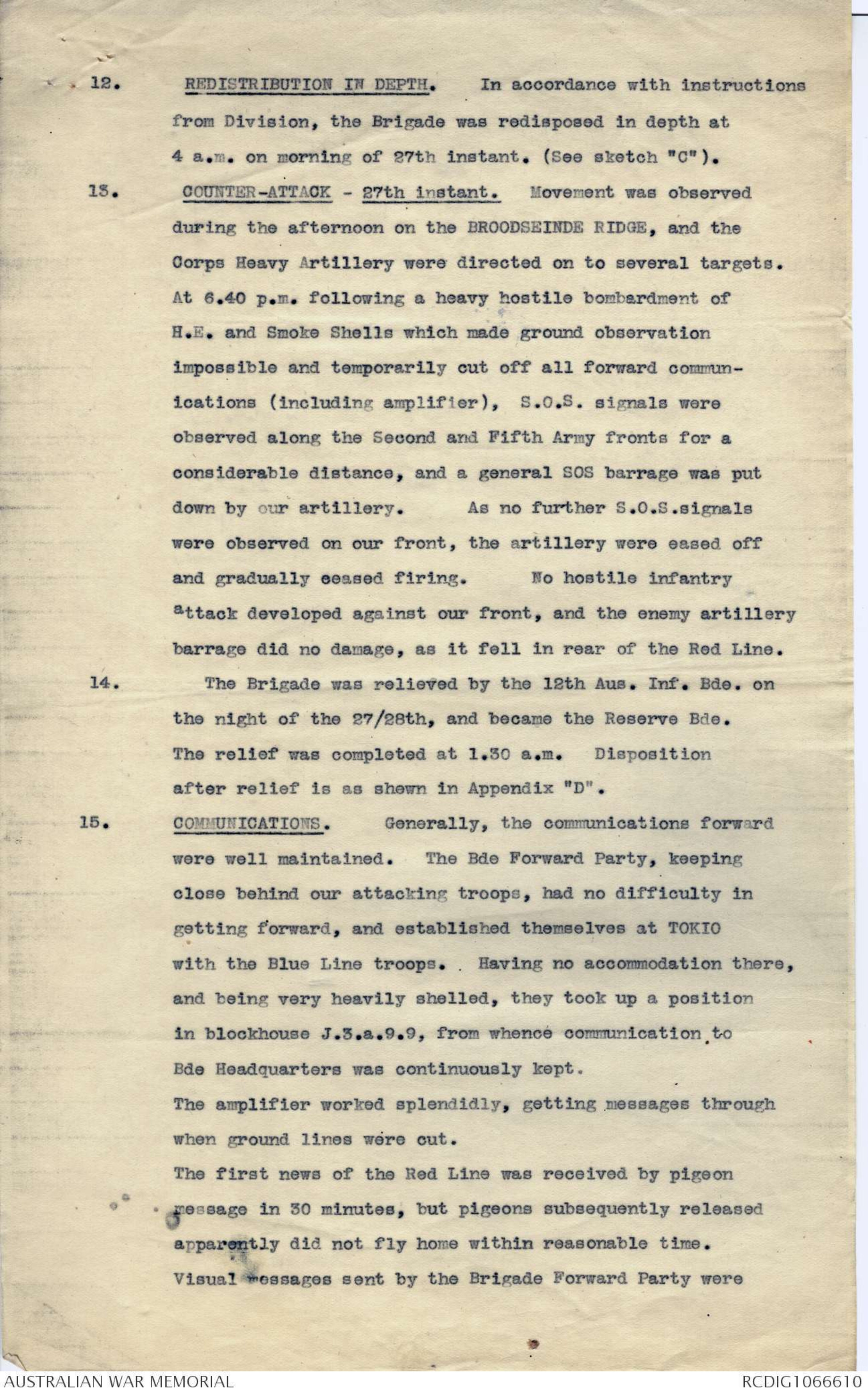
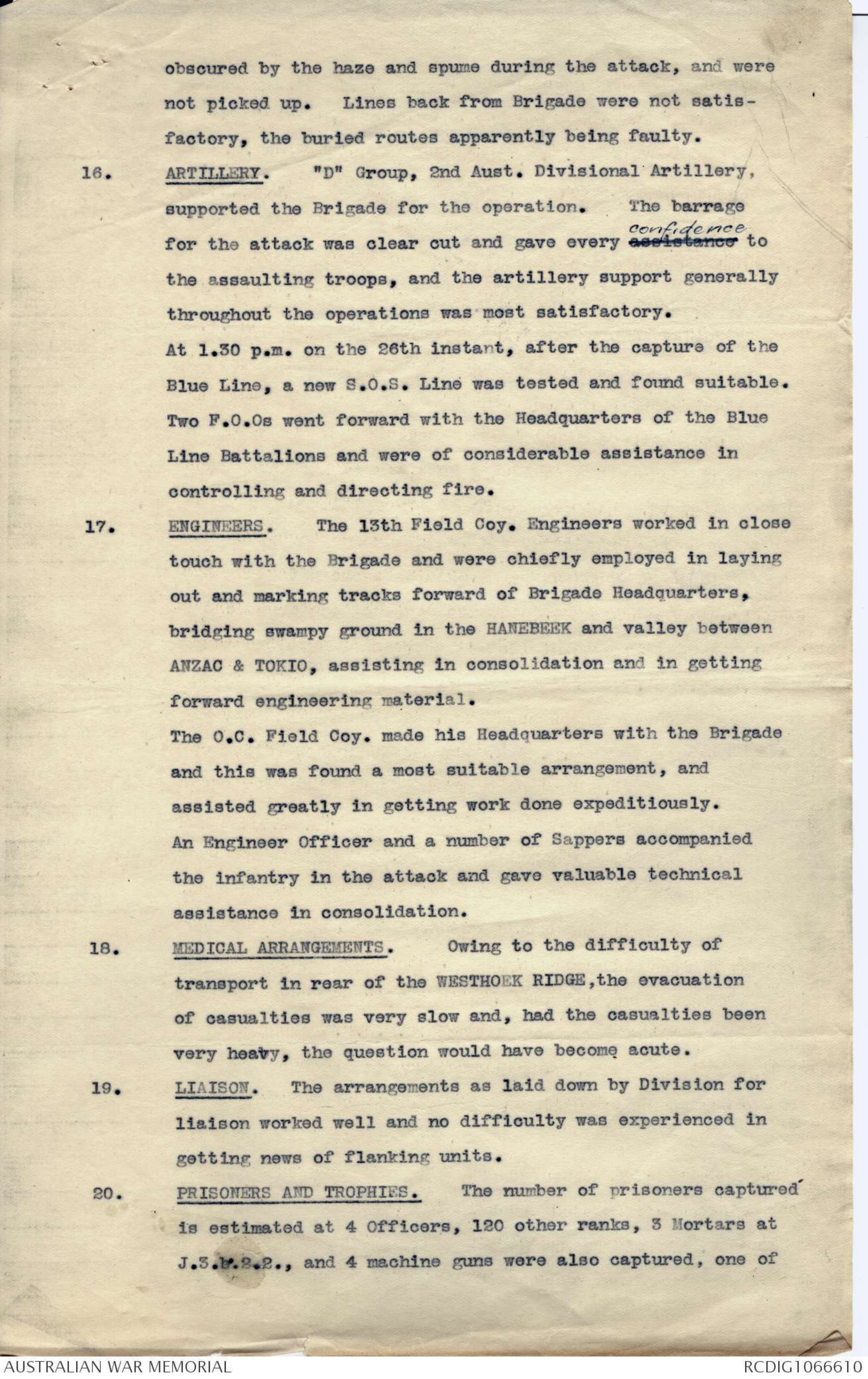

took every trouble to discipline the wasters. He
cut a very poor figure in connection with his row
with the Battalion. After being gratuitously
offensive without any cause at all when met
with determination he ^ ate his words and made an apology so
abject as to forfeit any respect the Btn might
have had for him. However that is entre nous
but I feel particularly bitter & some day when
I can get our friend by himself I hope to have it
out with him.
I was in London when the engagement
took place & saw several of the combatants at
Wandsworth hospital & send their impressions for
what they are worth.
Mr Heyes told me that you were
never engaged on the Menin Road battle & I often
picture you engaged at your work & am amazed
how you have been able to stand ^it so long. The strain on
your vitality must have been enormous. Your
present volume in my opinion will be about the
heaviest you have had to face. No 5 should be
easier but 6 will be ^a very important volume
though not so extensive as 4. To my idea 1917
was the most critical year of the War for during
it the Germans gained some very important successes.
& the end of the War seemed interminable
I sincerely hope when you have
got the history finally off your hands - say in
six years from date - you will be able to take
a twelve months absolute holiday.
With kind regards to you & Mr Bazley
Yours sincerely
Newton Wanliss
Glasgow. Polygon Wood 26/9/17
The deployment of two corps through the Menin Gate,
was a good performance, Glasgow thinks. He got his own men
out early in order to be sure.
On his flank was a Scottish unit. After the scrap
things looked a little shaky on that flank - men were seen
in some sort of movement which might have been a rearward
movement. A message however came through from the a Scottish
officer on the spot which was extraordinarily stouthearted
and had good effect: something like - “we are in (such and
such a position) - and we are staying there”.
Dear Bean.
Herewith report
as promised. Should
have sent it along
before but have
been having a
busy time in the
bog. The G. is
away one leave
at present. Col
Whitham is acting
C.O.
Sincerely yours.
R. Morell.
22/10/17
Capt C.E.W. Bean.
1st Anzac
13th. AUSTRALIAN INFANTRY BRIGADE.
Headquarters,
27th. September, 1917.
REPORT OF OPERATIONS SOUTH OF ZONNEBEKE FOR PERIOD
22nd SEPTEMBER to 27th SEPTEMBER 1917.
Reference Sheet 27. 1/40,000 and Maps attached.
1. On 21st September the 13th Australian Infantry Brigade
moved by bus from STEENVOORDE to CANAL AREA, and Brigade Headquarters were established at BELGIAN CHATEAU.
At 8 p.m. that night 4th Australian Divisional Preliminary
Instructions No. 1 were received, and Orders were issued the same
night for Units to j carry out reconnaissances of the area to
be taken over and the routes leading to it.
2. On 22nd September the G.O.C. and members of the Brigade
Staff visited the Headquarters of the 5th and 6th Australian
Infantry Brigades who were in the line, and made a personal
reconnaissance of the area to be taken over and arrangements
for the relief. Battalion and Coy. Officers also visited the
forward area. Very good observation of the area to be
attacked was obtained from J.d.65.10, and the Left Brigade
Boundary and portion of the objectives could be clearly seen.
3. On the night 22/23rd the 52nd Battalion relieved the 19th
Battalion, 5th Aus, Inf. Bde. on WESTHOEK RIDGE, and came
under the tactical command of the G.O.C. 6th. Aust. Inf. Bde.
On the morning of 23rd the 50th and 51st Battalions moved to
YPRES.
4. (a) On the morning of 23rd September a conference of
Commanding Officers (with the exception of O.C. 52nd Bn.)
was held at Bde H.Q. and the forthcoming operations were
discussed. At 12 noon Bde H.Q. moved to MURIEL DUGOUT
I.12.c.3.5, relieving the 5th Aus. Inf. Bde.
(b) On the night 23/24th the 52nd Bn. relieved the 21st Bn.
6th Aus. Inf. Bde. and the 50th Bn. moved to WESTHOEK RIDGE.
The relief was complete by 4.30 a.m. and the command of the
Sector passed from the G.O.C. 6th. Aust. Inf. Bde.
5. (a) On the 24th September at 12 noon Brigade Headquarters
moved to J.1.d.65.10.
(b) At 2.30 p.m. 4th Australian Divisional Preliminary
Instructions No. 2 were received and at 9.30p.m. Brigade
Preliminary Instructions No. 2 were issued.
6. At 12.30 p,m. Brigade Preliminary Instructions No. 3
for the approach to the "Jumping off" line and Divisional
Signalling Instructions were issued, and at 2.30 p,m. on
receipt of 4th Australian Divisional Order No. 80, Brigade
Order No. 89 was issued. Objectives and Boundaries of
Battalions are shown on map "A" attached.
7. (a) The move of the 49th and 51st Battalions from CANAL
AREA and YPRES to position of assembly west of WESTHOEK
RIDGE was carried out without a hitch, and only three
casualties occurred in the 2 Battalions. At 1 a.m. the
50th Bn. moved to the line of deployment which had
previously been taped by the Brigade and Bn. Intelligence
Officers, and at 1.30 a.m. the 49th and 51st Bns. formed
up in rear of them. The 50th Bn. occupied a depth of 60
yards & the 49th and 51st a depth of 90 yards each (See Map).
The positions were chosen because the enemy habitually
shelled the reverse slope of the ANZAC RIDGE, and the
intention was for all the attacking troops to move forward
as soon as the barrage started, and thus clear the enemy
counter-barrage. This was carried out, and in consequence,
the rear Battalions suffered very few casualties prior to
the actual attack on the Blue Line.
(b) The artillery barrage was very thorough, and the
attacking troops kept up close to it so that little
opposition was put up by the enemy infantry.
(c) A pigeon message from the 50th Bn. timed 7.25 a.m.
received at 7.50 A.M. reported the capture of the Red Line,
and 4 minutes later communication with the Brigade Forward
Party was established, and the 50th Bn reported that the
Red Line was being consolidated.
(d) At 9.10 a.m. a message from the 51st Bn. timed 8.15
a.m. reported capture of Left Sector Blue Line and that
touch had been established with Right Bn, and Left Bde.
At 9.15 a.m. a message from 49th Bn. timed 7.55 A.M.
reported capture of Right Sector Blue Line, and that we were
in touch with Right Brigade.
(e) Consolidation of both objectives was proceeded with
and the disposition of units, Machine Guns and Stokes Mortars
at 12 noon on the 26th. is as shown in sketch "B".
8. (a) EMPLOYMENT OF MACHINE GUNS.
2 sections of the 13th Aus. Machine Gun Coy. were employed
on barrage work under Divisional Machine Gun Officer. The
machine gun barrage was most satisfactory, and gave confidence
to the troops.
(b) The 8 mobile guns went forward with the last wave of
the troops for the Blue Line and took up positions which had
been previously indicated to them (See sketch "B").
9. EMPLOYMENT OF LIGHT TRENCH MORTARS.
4 STOKES guns were allotted to the Red Line Bn. and 2 each
to the Blue Line Bns. These guns were not employed during
the actual attack, but were employed subsequently against
Machine Guns in blockhouses in front of the Blue Line.
After consolidation, they were disposed as in sketch "B".
10. COUNTER-ATTACK: During the afternoon of 26th instant
enemy were reported massing: the artillery were directed on
them, but no counter-attack developed on the Bde Front.
At about 6.5 30 6.30 p.m. S.O.S. Signals were sent up on both
flanks, and the Group Artillery covering the Bde. Front
took up the signal, but within 5 minutes when it was
ascertained that it was not required, the barrage was
stopped.
11. CONSOLIDATION: The captured positions were consolidated
during the night 26/27th and small quantities of wire taken
up by the reserve Coys. in the attack were put out.
Working parties were, however, continually harrassed
by hostile machine guns and snipers.
12. REDISTRIBUTION IN DEPTH. In accordance with instructions
from Division, the Brigade was redisposed in depth at
4 a.m. on morning of 27th instant. (See sketch "C").
13. COUNTER-ATTACK - 27th instant. Movement was observed
during the afternoon on the BROODSEINDE RIDGE, and the
Corps Heavy Artillery were directed on to several targets.
At 6.40 p.m. following a heavy hostile bombardment of
H.E. and Smoke Shells which made ground observation
impossible and temporarily cut off all forward communications
(including amplifier), S.O.S. signals were
observed along the Second and Fifth Army fronts for a
considerable distance, and a general SOS barrage was put
down by our artillery. As no further S.O.S. signals
were observed on our front, the artillery were eased off
and gradually ceased firing. No hostile infantry
attack developed against our front, and the enemy artillery
barrage did not damage, as it fell in rear of the Red Line.
14. The Brigade was relieved by the 12th Aus. Inf. Bde on
the night of the 27/28th, and became the Reserve Bde.
The relief was completed at 1.30 a.m. Disposition
after relief is as shown in Appendix "D".
15. COMMUNICATIONS. Generally, the communications forward
were well maintained. The Bde Forward Party, keeping
close behind our attacking troops, had no difficulty in
getting forward, and established themselves at TOKIO
with the Blue Line troops. Having no accommodation there,
and being very heavily shelled, they took up a position
in blockhouse J.3.a.9.9, from whence communication to
Bde Headquarters was continuously kept.
The amplifier worked splendidly, getting messages through
when ground lines were out.
The first news of the Red Line was received by pigeon
message in 30 minutes, but pigeons subsequently released
apparently did not fly home within reasonable time.
Visual messages sent by the Brigade Forward Party were
obscured by the haze and spume during the attack, and were
not picked up. Lines back from Brigade were not satisfactory,
the buried routes apparently being faulty.
16. ARTILLERY. "D" Group, 2nd Aust. Divisional Artillery,
supported the Brigade for the operation. The barrage
for the attack was clear out and gave every assistance confidence to
the assaulting troops, and the artillery support generally
throughout the operations was most satisfactory.
At 1.30 p.m. on the 26th instant, after the capture of the
Blue Line, a new S.O.S. Line was tested and found suitable.
Two F.O.Os went forward with the Headquarters of the Blue
Line Battalions and were of considerable assistance in
controlling and directing fire.
17. ENGINEERS. The 13th Field Coy. Engineers worked in close
touch with the Brigade and were chiefly employed in laying
out and marking tracks forward of Brigade Headquarters,
bridging swampy ground in the HANEBEEK and valley between
ANZAC & TOKIO, assisting in consolidation and in getting
forward engineering material.
The O.C. Field Coy. made his Headquarters with the Brigade
and this was found a most suitable arrangement, and
assisted greatly in getting work done expeditiously.
An Engineer Officer and a number of Sappers accompanied
the infantry in the attack and gave valuable technical
assistance in consolidation.
18. MEDICAL ARRANGEMENTS. Owing to the difficulty of
transport in rear of the WESTHOEK RIDGE, the evacuation
of casualties was very slow and, had the casualties been
very heavy, the question would have become acute.
19. LIAISON. The arrangements as laid down by Division for
liaison worked well and no difficulty was experienced in
getting news of flanking units.
20. PRISONERS AND TROPHIES. The number of prisoners captured
is estimated at 4 Officers, 120 other ranks, 3 Mortars at
J.3.b.2.2., and 4 machine guns were also captured, one of
which was put into immediate use by us.
21. CASUALTIES. Our estimated casualties for the period
are 22 Officers and 22 500 other ranks.
22. GENERAL.
(a) It is considered that the numbers of men required
for the employment of Light Trench Mortar
Batteries during the attack (including carrying
parties) is altogether out of proportion to the
value of the guns. They are of little use
against concrete blockhouses, and few other
targets present themselves.
(b) Mule tracks from the back areas should be pushed
up as far and as quickly as possible after the
attack. Wet weather infantry tracks
forward should also be a work of primary
importance.
R Morell Major,
Brigade Major, 13th Australian Infantry Bde.
 Sam scott
Sam scottThis transcription item is now locked to you for editing. To release the lock either Save your changes or Cancel.
This lock will be automatically released after 60 minutes of inactivity.